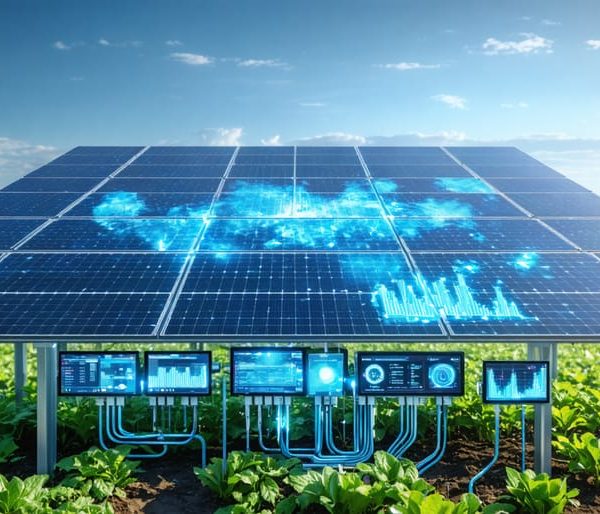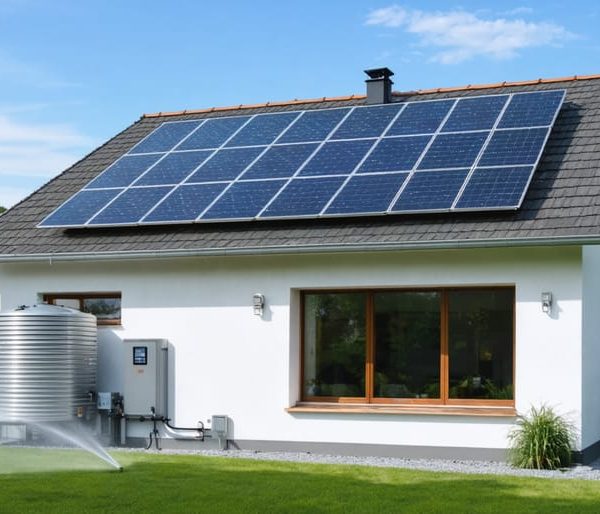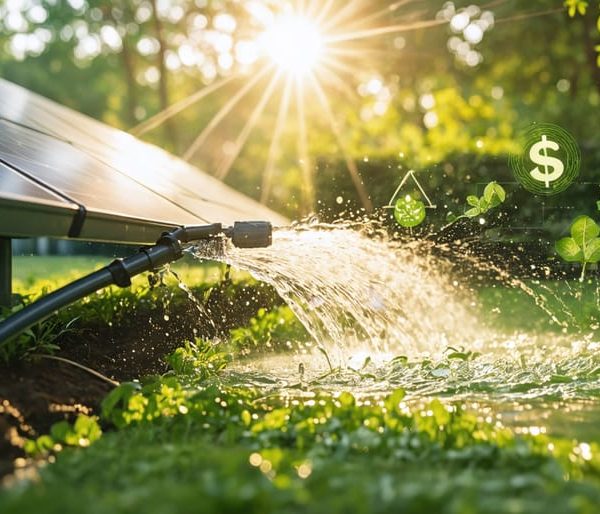Agrivoltaics: How Your Farm Can Generate Both Food and Solar Power
Imagine harvesting both food and clean energy from the same plot of land – that’s the groundbreaking promise of agrivoltaics. By combining solar panels with agricultural crops, these innovative systems are revolutionizing how we think about sustainable land use. Farmers across America are discovering that their fields can produce up to 70% more total value when they integrate solar panels with carefully selected crops that thrive in partial shade, like leafy greens, berries, and root vegetables.
Beyond maximizing land efficiency, agrivoltaics creates a powerful symbiotic relationship: the crops help keep solar panels cool, increasing their efficiency by up to 10%, while the panels provide shade that reduces water evaporation and protects plants from extreme weather. This dual-use approach isn’t just transforming rural farms – urban rooftops and community gardens are adopting these systems to create sustainable food and energy hubs in cities.
As climate change intensifies and land becomes increasingly precious, agrivoltaics represents a practical solution that addresses multiple challenges simultaneously: renewable energy generation, food security, and water conservation. Whether you’re a farmer looking to diversify income streams, a solar developer seeking innovative projects, or a community leader interested in sustainable development, agrivoltaics offers a compelling path forward in our transition to a more sustainable future.
Understanding Agrivoltaics: The Perfect Marriage of Agriculture and Solar Power
How Agrivoltaic Systems Work
Agrivoltaic systems create a harmonious partnership between solar power generation and agriculture by using the same land for both purposes. These innovative setups typically feature elevated solar panels mounted on sturdy frames above crops or grazing areas, usually at heights between 8 to 15 feet. This design allows farming equipment to operate underneath while providing partial shade that can benefit certain crops.
The solar panels are strategically positioned to optimize both energy generation and plant growth. They’re often installed in rows with carefully calculated spacing to ensure crops receive adequate sunlight throughout the day. Some advanced systems even use tracking technology to adjust panel angles, maximizing both solar efficiency and crop yield.
The dual-use approach creates several beneficial interactions. The panels provide shade that reduces water evaporation and protects plants from extreme weather, while the crops below help cool the panels through natural evaporation, improving their efficiency. The system can be customized based on specific crop needs and local climate conditions, making it adaptable for various agricultural settings, from small farms to large commercial operations.
For farmers and landowners, this setup offers a practical way to generate clean energy without sacrificing valuable agricultural land, truly embodying the concept of sustainable land use.

Benefits for Crops and Solar Generation
The beauty of agrivoltaics lies in its win-win benefits for both agriculture and solar energy production. Crops grown under solar panels often show remarkable improvements in yield, particularly in hot and dry climates. The panels provide partial shade that reduces water evaporation and protects plants from extreme heat stress, resulting in up to 30% less irrigation water needed.
Certain crops, like tomatoes, lettuce, and berry varieties, have shown yield increases of 20-30% when grown in these systems. The panels create a microclimate that helps maintain optimal growing conditions, protecting plants from harsh weather while allowing sufficient light for photosynthesis.
On the solar generation side, the presence of crops brings surprising advantages. The plants’ natural cooling effect through transpiration helps keep solar panels at lower temperatures, improving their efficiency by up to 3%. This cooling effect is particularly valuable during hot summer months when traditional solar installations typically see decreased performance.
Moreover, the vegetation beneath the panels reduces dust accumulation and helps maintain consistent ground temperatures, leading to more stable energy production throughout the year. This symbiotic relationship demonstrates how combining agriculture with solar technology can create more sustainable and productive land use.
Urban Agrivoltaics: Maximizing Limited Space
Rooftop Gardens with Solar Integration
Rooftop gardens combined with solar panels represent one of the most innovative approaches to urban solar integration, maximizing limited space while providing multiple benefits. These dual-purpose installations typically feature raised garden beds strategically positioned between solar panel arrays, creating a symbiotic relationship that enhances both systems’ performance.
The solar panels provide partial shade for heat-sensitive plants, while the plants’ natural cooling effect through evaporation helps maintain optimal temperature for the panels, increasing their efficiency by up to 15%. Popular crops for these setups include herbs, leafy greens, and compact vegetables that thrive in partially shaded conditions.
Implementation starts with a structural assessment of your roof, followed by the installation of a proper waterproofing membrane and drainage system. The solar mounting system is then integrated with modular garden beds, typically using lightweight growing mediums to minimize roof load.
Many commercial buildings have successfully adopted this approach, with some reporting combined energy savings and fresh produce values exceeding $30,000 annually. Residential implementations are gaining popularity too, especially in urban areas where garden space is limited.
To get started, consider consulting with both a solar installer and a rooftop garden specialist to develop a customized plan that maximizes your roof’s potential while ensuring structural integrity and optimal growing conditions.

Community Gardens and Solar Sharing
Community gardens are getting a sustainable upgrade through innovative community solar initiatives that combine food production with clean energy generation. These dual-purpose spaces allow urban residents to grow their own food while simultaneously harvesting solar power, making efficient use of limited city space.
Local groups are transforming unused lots and rooftops into productive areas where raised garden beds coexist with elevated solar panels. The panels provide partial shade for heat-sensitive crops while generating electricity for nearby buildings or community facilities. This arrangement creates a win-win situation: gardeners get comfortable growing conditions, and the community benefits from reduced energy costs.
Many neighborhoods are finding creative ways to make these systems work. For example, in Seattle, a community garden installed adjustable solar panels that can be tilted to optimize both energy production and plant growth throughout the seasons. Members share both the harvest and the energy credits, creating a stronger sense of community while advancing sustainability goals.
These shared spaces also serve as educational hubs where residents learn about renewable energy and sustainable agriculture. Children and adults alike can witness firsthand how modern technology and traditional farming practices can work together to create more resilient urban communities.
For communities interested in starting their own agrivoltaic garden, local solar cooperatives and gardening groups often provide resources and support to help get projects off the ground.
Rural Agrivoltaics: Transforming Traditional Farming
Crop Selection and Solar Panel Configuration
Successful agrivoltaic systems require careful consideration of both crop selection and solar panel arrangement. The key is choosing plants that thrive in partial shade conditions while maximizing energy generation. Leafy greens like spinach, lettuce, and kale are excellent choices, as they naturally prefer filtered sunlight and can be harvested multiple times per season.
For optimal results, solar panels should be installed at a height of 8-12 feet, allowing for comfortable farming operations underneath. Spacing between panel rows typically ranges from 12-20 feet, creating alternating bands of shade and direct sunlight that move throughout the day. This dynamic light pattern actually benefits many crops by protecting them from intense midday sun and reducing water evaporation.
Root vegetables like potatoes and carrots can also perform well in agrivoltaic systems, particularly when planted in the sunny corridors between panel rows. Shade-tolerant herbs such as mint, oregano, and parsley thrive in the partial shade zones directly under panels.
When configuring your solar array, consider using bifacial panels that can capture reflected light from the ground, increasing overall energy yield. Tracking systems that adjust panel angles throughout the day can further optimize both energy production and crop growth, though they require higher initial investment.
Remember to factor in seasonal changes when planning your layout – winter sun angles will create different shade patterns than summer positions.
Maintenance and Management Strategies
Successful agrivoltaic systems require regular attention to both the solar installation and agricultural components. For optimal performance, establish a routine inspection schedule focusing on both the panels and crops. Clean solar panels quarterly, or more frequently in dusty areas, to maintain maximum energy production. Use soft brushes and appropriate cleaning solutions to avoid scratching the panels.
Monitor plant growth patterns and adjust panel positioning if needed to ensure proper light distribution. Keep detailed records of crop yields and energy production to identify areas for improvement. Regular soil testing helps maintain optimal growing conditions, while checking electrical connections and wiring prevents system inefficiencies.
Install weather monitoring systems to track environmental conditions affecting both power generation and crop growth. This data helps optimize irrigation schedules and predict maintenance needs. Consider implementing automated systems for irrigation and panel cleaning to reduce manual labor.
For larger installations, develop a comprehensive maintenance schedule that includes both preventive and reactive maintenance protocols. Train staff in both agricultural and solar system maintenance to ensure efficient operation. Keep spare parts on hand for common repairs, and establish relationships with local solar technicians and agricultural experts for specialized support.
Remember to maintain clear access paths between panel rows for equipment and workers. Regular pruning and vegetation management prevent unwanted shading and ensure easy maintenance access. Document all maintenance activities and system modifications for future reference and continuous improvement.
Getting Started with Your Own Agrivoltaic Project
Planning and Assessment
Before launching an agrivoltaics project, thorough planning and assessment are essential for success. Start by evaluating your land’s solar potential through a site analysis, considering factors like sun exposure, shade patterns, and existing vegetation. Assess your property’s soil quality and agricultural capabilities to determine which crops will thrive alongside solar panels.
Next, review local zoning laws and permit requirements, as some areas have specific regulations for combined solar and agricultural installations. Consider working with an experienced solar installer who understands agrivoltaic systems and can help optimize the panel layout for both energy production and farming activities.
Calculate your energy needs and crop production goals to find the right balance between the two. This includes determining panel height, spacing, and orientation to ensure adequate light reaches the crops while maximizing power generation. Don’t forget to factor in water management systems, as proper irrigation is crucial for both components.
Finally, develop a detailed budget that accounts for initial installation costs, maintenance requirements, and potential revenue streams from both energy production and agricultural yields.
Installation Guidelines
Proper installation of agrivoltaics systems requires careful planning and attention to detail. Start by conducting a thorough site assessment, evaluating factors like sun exposure, soil quality, and existing agricultural activities. Your layout should prioritize both optimal solar panel placement and crop spacing for maximum efficiency.
For ground-mounted systems, install robust support structures that can withstand weather conditions while maintaining adequate height for farming activities beneath. The recommended panel height typically ranges from 8 to 12 feet, allowing for comfortable machinery access and proper crop growth. Consider using bifacial solar panels, which can capture reflected light from crops below, enhancing overall energy production.
Irrigation systems should be integrated thoughtfully, with water-resistant components and proper cable management to prevent interference with farming operations. When designing your setup, consider implementing an off-grid solar system design that accommodates both power generation and agricultural needs.
Installation timing is crucial – schedule panel mounting during crop rotation periods to minimize disruption to agricultural activities. Always work with certified installers who understand both solar and agricultural requirements. They should follow local building codes and secure necessary permits while ensuring proper grounding and weather protection for all electrical components.
Regular maintenance pathways should be incorporated into the design, allowing easy access for both panel cleaning and crop management. Remember to document the installation process and maintain detailed records for future reference and system optimization.
Cost Considerations and ROI
The initial investment in agrivoltaics systems typically ranges from $2.50 to $3.50 per watt, with costs varying based on project scale and location. While this may seem substantial, the dual benefits of crop production and sustainable power generation create multiple revenue streams that significantly improve ROI.
Most agrivoltaic installations see a return on investment within 5-8 years, compared to 8-10 years for traditional solar installations. This accelerated payback period comes from combining energy savings with enhanced crop yields, which can increase by 10-60% for shade-tolerant plants.
Federal and state incentives, including tax credits and agricultural grants, can reduce initial costs by 26-30%. Additionally, many farmers report reduced water consumption by up to 30%, leading to substantial operational savings. Some installations have demonstrated annual returns of $9,000-$14,000 per acre when combining energy production and crop sales.
Remember to factor in maintenance costs, which typically run 1-2% of the initial investment annually, but are offset by the dual-income streams and reduced resource usage.

Agrivoltaics represents a groundbreaking solution that transforms the way we think about land use and renewable energy. By combining solar power generation with agricultural activities, we’re not just maximizing space – we’re creating a sustainable future that benefits both farmers and energy consumers. The success stories we’ve seen, from small urban farms to large commercial operations, demonstrate that this innovative approach is both practical and profitable.
As we face increasing challenges from climate change and growing food demand, agrivoltaics offers a path forward that addresses multiple needs simultaneously. The data speaks for itself: improved crop yields, enhanced water efficiency, and significant energy generation make this a win-win solution for environmentally conscious property owners and businesses alike.
Whether you’re a homeowner with a backyard garden or a commercial property manager overseeing extensive grounds, agrivoltaics could be your next step toward sustainability. The technology is mature, the benefits are clear, and the time to act is now. By embracing this dual-use approach, you’re not just investing in renewable energy – you’re participating in a movement that’s reshaping our relationship with land and resources.
Consider starting small with a pilot project, perhaps over a portion of your garden or agricultural space. The lessons learned from early adopters show that with proper planning and implementation, agrivoltaics can deliver remarkable results while contributing to a more sustainable future for all.











